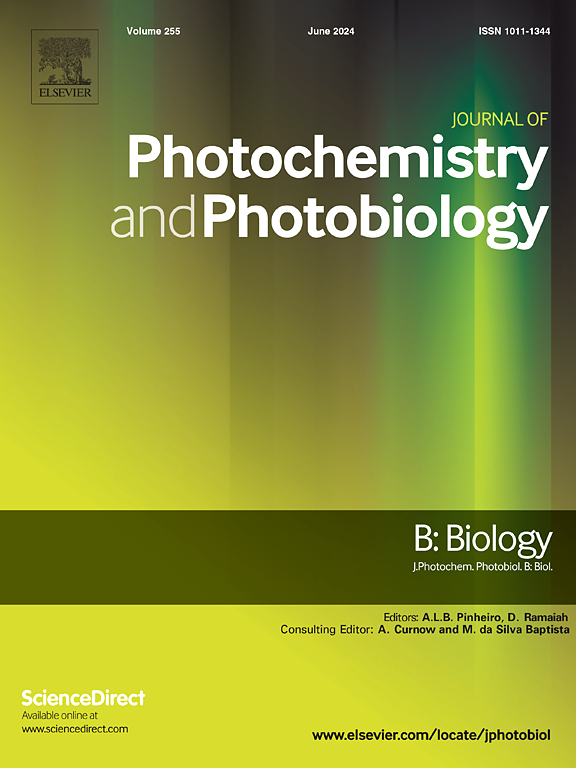Mechanistic insights into temoporfin-based photodynamic therapy: Ferroptosis as a critical regulator under normoxic and hypoxic conditions in head and neck cancer
IF 3.7
2区 生物学
Q2 BIOCHEMISTRY & MOLECULAR BIOLOGY
Journal of photochemistry and photobiology. B, Biology
Pub Date : 2025-04-18
DOI:10.1016/j.jphotobiol.2025.113165
引用次数: 0
Abstract
Temoporfin is a second-generation photosensitizer used in photodynamic therapy (PDT) for the clinical treatment of head and neck cancer. However, its role in inhibiting cancer cell viability under normoxic and hypoxic conditions remains unclear. The oral squamous cell carcinoma (OSCC) cell lines, SAS and OECM-1 were cultured under normoxic or hypoxic conditions to investigate temoporfin-based PDT-induced cell death and the underlying mechanisms. Cell viability was analyzed using the MTT assay. Intracellular reactive oxygen species (ROS) levels, cell apoptosis, intracellular ROS, iron levels, lipid peroxidation, and glutathione (GSH) levels were assessed by flow cytometry. The expression of proteins related to oxidative stress, apoptosis, autophagy, and ferroptosis was verified by western blotting. Results showed that increasing the temoporfin dose, absorption time, and illumination time was positively correlated with the inhibition of oral cancer cells. Hypoxic conditions attenuated the toxicity of temoporfin in cancer cells. OECM-1 cells were more sensitive to temoporfin than SAS cells. Temoporfin-based PDT-induced ROS exhibited similar trends to oxidative stress-inducing enzymes under both normoxic and hypoxic conditions and triggered cell autophagy and ferroptosis. Administration of the ferroptosis inhibitor BRD4770 under normoxic conditions reversed temoporfin-based PDT-induced reductions in glutathione peroxidase 4 (GPx4), increasing in light chain 3-II (LC3-II) and cleaved poly (ADP-ribose) polymerase (cleaved-PARP). This study confirms that hypoxia weakens the anticancer effects of temoporfin-based PDT and that ferroptosis plays a key role in temoporfin-based PDT-mediated cancer cell inhibition.

以温度为基础的光动力疗法的机制见解:铁下垂是头颈癌在常氧和缺氧条件下的关键调节因子
Temoporfin是第二代光敏剂,用于光动力治疗(PDT)头颈癌的临床治疗。然而,其在常氧和缺氧条件下抑制癌细胞活力的作用尚不清楚。在常氧或缺氧条件下培养口腔鳞癌(OSCC)细胞系、SAS和OECM-1,研究基于温度的pdt诱导的细胞死亡及其潜在机制。采用MTT法分析细胞活力。流式细胞术检测细胞内活性氧(ROS)水平、细胞凋亡、细胞内ROS、铁水平、脂质过氧化和谷胱甘肽(GSH)水平。氧化应激、细胞凋亡、自噬和铁下垂相关蛋白的表达经western blotting验证。结果表明,增加剂量、吸收时间和照射时间与口腔癌细胞的抑制作用呈正相关。低氧条件减弱了温波尔芬对癌细胞的毒性。OECM-1细胞对温度变化的敏感性高于SAS细胞。在常氧和缺氧条件下,以温oporfin为基础的pdt诱导的ROS表现出与氧化应激诱导酶相似的趋势,并引发细胞自噬和铁下垂。在常氧条件下给予铁下沉抑制剂BRD4770逆转了以温度为基础的pdt诱导的谷胱甘肽过氧化物酶4 (GPx4)的减少,轻链3-II (LC3-II)和裂解聚(adp核糖)聚合酶(裂解- parp)的增加。本研究证实,缺氧削弱了温oporfin-based PDT的抗癌作用,而铁凋亡在温oporfin-based PDT介导的癌细胞抑制中起关键作用。
本文章由计算机程序翻译,如有差异,请以英文原文为准。
求助全文
约1分钟内获得全文
求助全文
来源期刊
CiteScore
12.10
自引率
1.90%
发文量
161
审稿时长
37 days
期刊介绍:
The Journal of Photochemistry and Photobiology B: Biology provides a forum for the publication of papers relating to the various aspects of photobiology, as well as a means for communication in this multidisciplinary field.
The scope includes:
- Bioluminescence
- Chronobiology
- DNA repair
- Environmental photobiology
- Nanotechnology in photobiology
- Photocarcinogenesis
- Photochemistry of biomolecules
- Photodynamic therapy
- Photomedicine
- Photomorphogenesis
- Photomovement
- Photoreception
- Photosensitization
- Photosynthesis
- Phototechnology
- Spectroscopy of biological systems
- UV and visible radiation effects and vision.

 求助内容:
求助内容: 应助结果提醒方式:
应助结果提醒方式:


